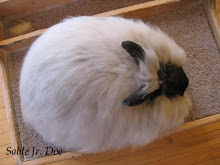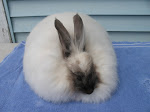Just posting another old article as I muck my way through the last crazy week of school. More pictures and stuff will be coming up soon as I revert to normal bunny life in a week or so. Thanks for being patient!:-)
Now that Spring is on it's way (we hope) and many of us will begin to breed in earnest over the next couple of months, I thought it would be a good time to post an excellent description of 'Parturition and Maternal Care' found in the 'Rabbit Production' book, 8th Edition, on pg. 254. Many of us die-hard rabbit people already have this book on our shelves, but I find that I refer to it again and again, especially the Chapter on 'Rabbit Production', which is concise and well-written:). Here is an excerpt:
"During the last week of pregnancy, the corpus luteum secretes prostaglandin, which destroys the corpus luteum and markedly reduces progestin secretion. There is also an increase in the hormone prolactin, which stimulates the behavior known as nest building. Nest Building is seen a few days before parturition and involves building a "material nest" of hay, straw, or whatever nest material is provided. In the day or so prior to kindling there is a loosening of the hair on the belly, thighs, and dewlap. The doe pulls this hair and interweaves it with the material nest to form the "maternal nest". The quality of the maternal nest and the time at which the nest building occurs depend on the breed of the doe, her previous experience (the quality of the nest tends to improve with successive litters), the nesting material available, and the season of the year.
Parturition occurs in response to a decrease in the progestin levels (which maintain the uterine muscles in a quiet state during pregnancy), and an increase in estrogen and prostaglandin levels, and the sudden release of the hormone oxytocin from the posterior pituitary. The exact stimulus for this release is not known. Oxytocin, estrogen, and prostaglandin stimulate contractions of the uterine musculature, which force out the kits. Reflex contractions of the abdominal musculature also assist in the birth process.
Parturition in the rabbit normally occurs in the early morning, taking about 30 minutes, with individual kits born at intervals of 1 to 5 minutes. The doe crouches in the nest and licks each of the young as it is delivered. This dries the kits, removes blood and tissue debris, and stimulates blood circulation. The firstborn kits generally begin nursing before the rest of the litter is born. This may assist in the birth process, since the suckling stimulus will result in further release of oxytocin. The entire litter is generally delivered at one time, although it may be spread over one to two days. Occasionally a single fetus will be delivered a day or more before the remainder of the litter. The kits are hairless, blind, and deaf at birth.
When parturition is complete, the doe eats the placenta and dead kits. This is common behavior among animals, even noncarnivores like the rabbit. Since the waste material may attract predators or act as a medium for the growth of bacteria, such behavior increases the chances of survival of the young.
Pg. 256
Some does, especially those that are young or exceptionally nervous or those that are disturbed during kindling, may give birth outside the nest (scattering) or may eat some or all of the young (cannibalism). The causes of these abnormal behaviors are not known, although they are most often seen with does that build poor nests. A doe that persists in either behavior for several successive litters should be culled. Scattering of the litter often results in loss of the kits because rabbits, unlike other species such as cats, do not return kits to the nest.
The doe normally nurses the litter only once each day for about four or five minutes. Prior to her arrival, the kits move to the top of the nest material to facilitate reaching the nipples. The kits change nipples very frequently during the early part of suckling, remain relatively quiet through the middle of the period, and then begin moving rapidly toward the end. At the end of suckling, the doe deposits several fecal pellets in the nest box and abruptly leaves. This is independent of whether the kits are still nursing. The kits are stimulated to urinate by wet or cold, so because of the dampness from nursing, they all urinate. They begin a pattern of behavior that includes digging through the nest material for 15 to 30 minutes. This serves to fluff and dry the nest. After this, the kits form into a group and remain quiet for about 22 hours when they again move to the top of the nest material to await the doe.
Contrary to popular belief, the doe does little to maintain the nest or the kits. she may lick one or more of the kits during suckling, but this appears to be for recognition rather than for stimulation of urination and defecation as previously thought. There is no evidence that the doe needs to lick the kits for stimulation of either of these functions."
'Rabbit Production' is a wealth of information for rabbit raisers simply because it is scientific but simultaneously easy and interesting to read:). It is a bit on the pricey side in the cage catalogs (approx. $40.00, I believe), but it is well worth the price in better knowledge of your rabbits and their needs. Many breeders, both Angora and otherwise, refer to it as much as any other book they have, perhaps more:).
Monday, June 9, 2008
Subscribe to:
Post Comments (Atom)























No comments:
Post a Comment